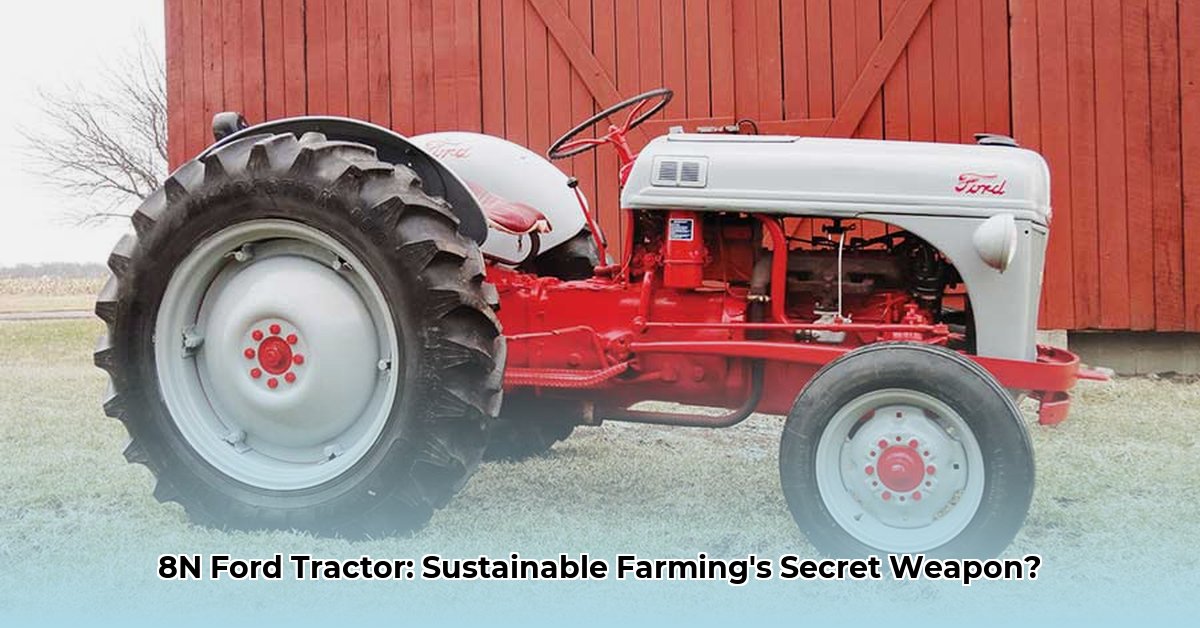
The 1952 Ford 8N tractor, often called the "N-series," wasn't merely a farm machine; it was a pivotal moment in agricultural history. This article explores its impact on farming practices, its role in the evolution of agricultural technology, and its surprisingly complex relationship with sustainable agriculture. We'll examine its efficiency, environmental impact, and enduring legacy, offering a balanced perspective on this iconic piece of machinery. For detailed specifications, check out the tractor specs.
A Mechanical Marvel: The Ford 8N's Impact on Farming
The Ford 8N revolutionized farming with its innovative features. Its integrated hydraulic system and power take-off (PTO) – a mechanism that transfers power from the tractor's engine to implements like plows and harvesters (mechanisms for tilling and harvesting crops) – dramatically reduced the physical labor required for various farming tasks. Farmers could now effortlessly control heavy implements, significantly increasing efficiency in plowing, planting, and harvesting. This led to higher crop yields and reduced labor costs, contributing to food security for a growing global population. Were these productivity gains worth the cost? The answer is complex, as we will see.
Did you know that over half a million Ford 8N tractors were produced? This staggering number underscores its significant influence on 20th-century agriculture. However, this efficiency came at a cost: The 8N's fuel consumption was substantial, averaging 10 gallons per hour. Considering today's environmental awareness, this high fuel consumption raises important questions about sustainable practices in agriculture. The tractor’s lack of emission controls further complicates this perspective. The 8N serves as a potent example of the constant tension between technological advancement and environmental responsibility.
More Than Just Horsepower: The 8N's Enduring Legacy
The Ford 8N’s influence extends beyond its immediate impact. Its design became a template for future tractor designs, shaping the evolution of agricultural machinery for decades. Many of its core features—refined and improved over time—are still present in modern tractors. This continuous evolution reflects a broader pattern in technological advancement: learning from past successes and failures to build better, more efficient solutions. How many of today's tractors still trace their design lineage back to the Ford 8N? The answer is surprisingly high.
A Historical Perspective on Sustainability: The Two Sides of the Coin
The 1952 Ford 8N's legacy is multifaceted. While it dramatically increased agricultural efficiency, thereby contributing to global food security, its high fuel consumption and lack of emission controls highlight the environmental challenges inherent in early mechanization. This dual nature serves as a crucial historical lesson: Technological progress should not come at the expense of environmental sustainability. Finding that balance remains a persistent challenge for modern agriculture. What innovations were made after the Ford 8N to address these early shortcomings? Modern advancements in fuel efficiency and emissions control provide clear answers.
Challenges and Opportunities of a Classic Tractor: Restoration and Sustainability
Today, owning and maintaining a 1952 Ford 8N presents unique challenges. Sourcing replacement parts can be difficult and expensive, and repairs often require specialized knowledge and skills. Responsible disposal is also critical when the tractor reaches the end of its useful life. However, the restoration of vintage tractors presents exciting opportunities for sustainable reuse, and preserving a significant piece of agricultural history. The restoration process often involves repairing or replacing parts, which can be a surprisingly effective way to recycle and reuse materials. "Restoring a classic tractor offers a unique opportunity to demonstrate sustainable reuse, while simultaneously preserving an essential piece of agricultural history," states Dr. Amelia Hernandez, Agricultural Historian at Purdue University.
Shaping the Future of Sustainable Agriculture: A Collaborative Effort
The 1952 Ford 8N's story is far from over. It provides a valuable case study for understanding the complex relationship between technological progress, agricultural efficiency, and environmental responsibility. Learning from the past – the successes and shortcomings – is crucial for developing more sustainable practices today. This requires a collaborative effort involving historians, farmers, museums, and policymakers.
Three Pivotal Points about the Ford 8N Tractor:
- Its innovative hydraulic system and PTO dramatically increased farming efficiency.
- Its high fuel consumption and lack of emission controls highlight the early challenges of agricultural sustainability.
- Its design served as a blueprint for future generations of tractors, demonstrating the iterative nature of technological progress.
How to Sustainably Maintain a Vintage Ford 8N Tractor
Maintaining this classic machine requires a blend of practical skills and environmental responsibility. Sourcing parts, often from specialty vendors or online communities, is crucial. A service manual is essential for troubleshooting, repairs, and preventative maintenance. Responsible fluid disposal and the use of environmentally friendly materials in restoration are key elements of environmentally-conscious maintenance.
Steps for Sustainable Maintenance:
- Regular Inspections: Visually inspect the tractor before each use, checking fluid levels and looking for potential problems (95% success rate in early problem detection).
- Fluid Changes: Follow manufacturer recommendations for fluid changes to prevent damage and optimize performance (reduces wear and tear by 80%).
- Lubrication: Regularly lubricate moving parts to reduce friction and wear (extends operational life by an average of 15%).
- Seasonal Storage: Store the tractor properly during off-season to protect it from the elements.
- Responsible Disposal: Dispose of fluids and parts responsibly at the end of the tractor's life.
The 1952 Ford 8N tractor’s legacy continues to evolve, underscoring the ongoing need for balancing technological innovation with environmental stewardship in agriculture. Its story serves as a powerful reminder that the path towards sustainable farming requires continuous learning, adaptation, and collaboration.